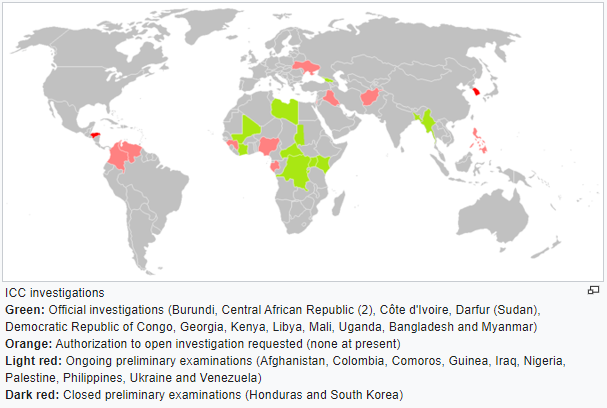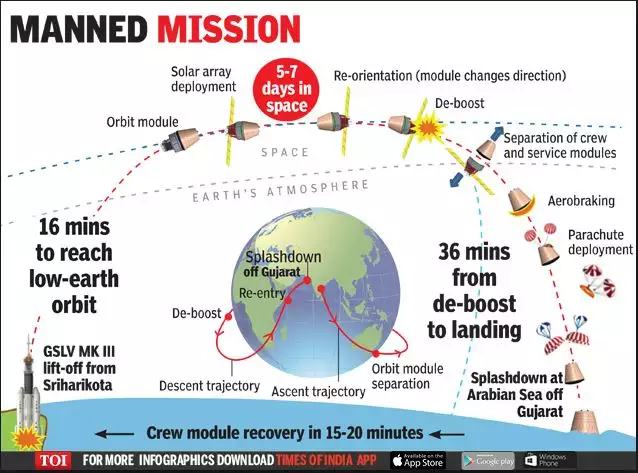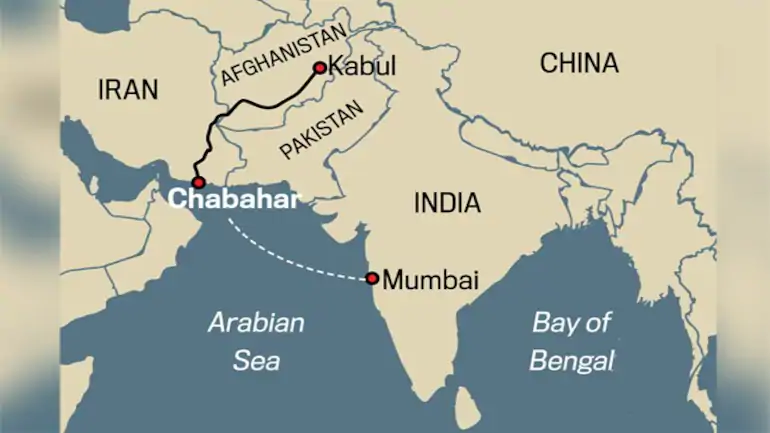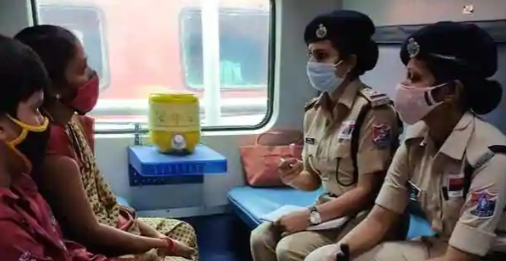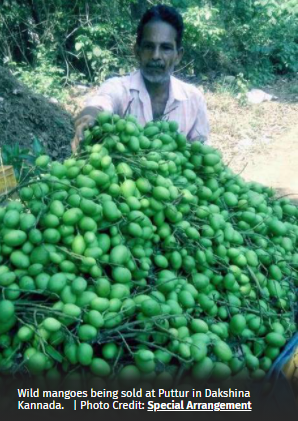
In News: Recently, three candidates from the Municipal Corporations of Vadodara and Rajkot have been disqualified under the two-child policy in Gujarat.
Gujarat’s two-child Policy
- In 2005, the Gujarat government amended the Gujarat Local Authorities Act to prevent a person having more than two children, to be a member of panchayat or the councilor of a municipality or municipal corporation.
- The amendment also added the clause to the other Acts governing elections to local administrative bodies. For example:
- Gujarat Provincial Municipal Corporations Act, 1949.
- Gujarat Panchayats Act, 1993.
- Aim: To order and stabilize the growing population of the country, beginning with elected representatives.
Cut off Date and Exceptions
- The representatives with more than 2 children before the commencement of the act were allowed to contest provided they use family planning post-commencement. There was a window of 1 year till 2006 period for full compliance.
- The twins and triplets were taken as an exception and their parents were exempted from any debarment from contesting elections.
- Divorcees and adoptions have not been given an exception.
- Biological children who were born alive, regardless of the duration of survival, are also counted as “one entity”.
- Even the sitting representatives can be disqualified if a third child is born during the tenure.
Two-child Policy in the Other States
- The Assam Cabinet is underway to implement the two-child policy as eligibility criteria for government jobs from 2021.
- Rajasthan
- The Rajasthan Panchayati Raj Act, 1994 says that if a person has more than two children, (s)he will be disqualified from contesting the election as a Panch or a member.
- In Rajasthan, any person having more than 2 children cannot be appointed in a government job.
- Madhya Pradesh
- Madhya Pradesh Civil Services (General Condition of Services) Rules: Two child policy in government jobs since 2001.
- There was a two-child policy in local body elections until 2005, which was later repealed on the ground that such provisions do not apply for the Parliament and Assembly elections.
- Similar provisions have been implemented by Telangana, Andhra Pradesh, Maharashtra, Odisha, Karnataka.
Need and History of Two-Child Policy
- India will overtake China as the world’s most populous country around 2031 (as per the National Commission on Population under the Ministry of Health and Family Welfare).
- Overstressed Infrastructure and Urban Centres: Excess population is creating overloaded infrastructure.
- Demographic Curse: In absence of enough skilling resources, the booming population is bound to be a disaster with more mouths to feed in comparison to the productive hands.
- History
-
- The debate for 2 child policy started even before the start of the 1st Lok Sabha.
- During the Emergency imposed by the Indira Gandhi government in the 1970s, the two-child policy got an aggressive push.
- During the 1980s,
- “Hum Do Hamare Do” (We Two Ours Two) was popularised through the mass campaign.
- The National Health Policy was adopted.
- India became a signatory to the International Conference on Population and Development Declaration in 1994.
- The National Population Policy came in 2000 with the long-term objective of stabilizing the population by 2045.
Criticisms
- Mahatma Gandhi was opposed to any policy which forced people to have only two children. He advocated attitudinal change.
- Religious Prism: Few people have given this policy a religious tone pitching it as detrimental to religious rights and beliefs.
- No Need of 2 Child Policy: As per NFHS-5, the use of contraceptives is on the rise with the rural-urban gap narrowing. This is a clear sign of the efficacy of awareness campaigns over statutory (legal) actions.
- Already the fertility rate is declining in India from 3 children per woman in 2000 to slightly above the replacement level of 2.1 per woman in 2020.
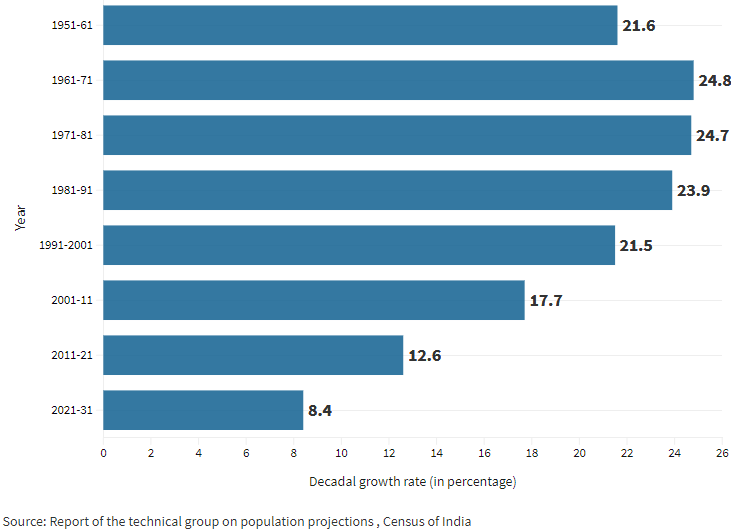
- Ageing Population: Now an aging population can be seen in China due to the forced one-child policy.
- Against the Right to choose and Dignified life (Article 21): Sometimes due to failure of contraceptives, a third child may be born.
- Accidental Deaths: Many acts passed by states don’t consider child mortality in mind. It may render parents childless without any option.
- Disability and Divorcee: The complex social stigmas around adoption, disability, and divorcees may create complications in the implementation of 2 child policy.
- Rural illiterate old-age persons: The capability to administer has nothing to do with the number of children, much like the educational criteria. Hence, it can be a hurdle in the election of a popular and efficient person having more than two children.
Way Ahead:
- The empowerment via different contraceptive options and awareness via different NGOs can be a great tool rather than coercive action. The government must focus on managing the population boom and migration towards urban centers through the development of urban centers into skilling and employment hubs.
Source: IE
(Broad Topic: GS II, International Relation, India-Israel Relations)
Israel-India on ICC Ruling
In News: Israel is seeking India’s help to pressurize International Criminal Court (ICC) to give up its jurisdiction over the Palestinian Issue.
- India not being a member of Rome statute is not willing to take a stand on any decision of ICC.
- ICC’s majority 2-1 decision was made on the basis of Palestine’s 2015 accession to the Rome Statute after its acceptance as a “non-member observer state” of the UN General Assembly in 2012.
- Israel is opposing ICC because
- Israel does not recognize the (ICC) court’s jurisdiction.
- the Palestinian Authority is not a sovereign state as per Israel.
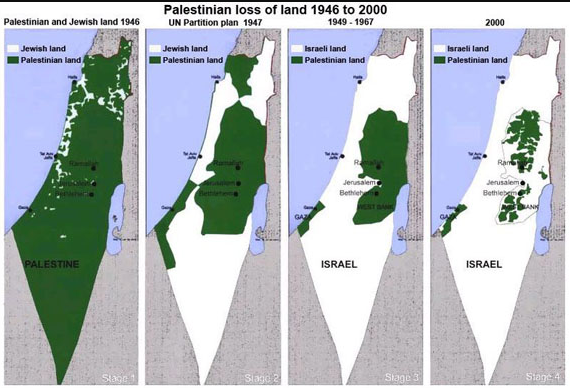
(Image Source: The Economist)
|
About International Criminal Court (ICC):
|
|
About India-Israel Relation:
|
Source: IE
Broad Topic: GS I/GEOGRAPHY
World Sustainable Development Summit 2021&
In News – Recently, the Prime Minister inaugurated the World Sustainable Development Summit 2021.
- The theme of the Summit is ‘Redefining our common future: Safe and secure environment for all’.
Key Points:
- The Prime Minister emphasized climate justice for fighting against climate change.
- Climate justice is inspired by a vision of trusteeship- where growth comes with greater compassion to the poorest.
- Climate justice also means giving developing countries enough space to grow.
- The country is committed to reducing the emissions intensity of GDP by 33 to 35 percent from 2005 levels.
India’s Achievements and Efforts:
- India is making steady progress on its commitment to Land Degradation Neutrality.
- Renewable energy is also picking speed in India.
- The country is on track to set up 450 gigawatts of Renewable Energy generating capacity by 2030.
- In March 2019, India achieved nearly a hundred percent electrification.
- This was done through sustainable technologies and innovative models.
- Ujala program– The scheme is being named “UJALA” – an acronym for Unnat Jyoti by Affordable LEDs for All. This has reduced over thirty-eight million tonnes of carbon dioxide per year.
- The Jal Jeevan Mission -Aims to provide a tap water connection to every rural household by 2024. It has connected over thirty-four million households with tap connections in just about 18 months.
- PM Ujjwala Yojna-It is a scheme of the Ministry of Petroleum & Natural Gas for providing LPG connections to women from Below Poverty Line (BPL) households. Through the PM Ujjwala Yojna, more than 80 million households below the poverty line have access to clean cooking fuel
- International Solar Alliance.-The ISA plays a four-fold role in establishing a global solar market: it is an accelerator, an enabler, an incubator, and a facilitator.
- Special attention towards animal protection-in the last five to seven years, the population of lions, tigers, leopards and Gangetic river dolphins have gone up.
- This was done through sustainable technologies and innovative models.
About the World Sustainable Development Summit
- It is the annual flagship event of The Energy and Resources Institute (TERI) instituted in 2001.
- The Summit series has marked 20 years in its journey of making ‘sustainable development’ a globally shared goal in the year 2021.
- The Summit has established itself as a responsible and effective platform for mobilizing opinion-makers to identify and advance pioneering actions to address some of the most relevant issues concerning sustainable development.
|
The Energy and Resources Institute (TERI):
|
Broad Topic: GS III, Science & Technology
Gaganyaan Mission
In News
In a recent reply in Lok Sabha, it has been informed that the human spaceflight module of Gaganyaan would be launched after the second unmanned mission planned in 2022-23.
About Gaganyaan Mission
- It aims to take Indian astronauts to space i.e. in Low Earth Orbit (LEO) by 2022 and will be the first human mission indigenously developed by the Indian Space Research Organisation (ISRO).
- LEO is an Earth-centred orbit with an altitude of 2,000 km or less.
- The mission is expected to cost less than Rs. 10,000 crore.
- With this, India could potentially become the fourth country to send a man to space, after the erstwhile USSR, US, and China.
- Denmark also has a manned space flight scheduled for 2022.
- Launch Vehicle: GSLV Mk III, the three-stage heavy-lift launch vehicle, will be used as it has the necessary payload capability.
- Objectives and Significance of the Mission
- Enhancement of science and technology levels in the country.
- Improvement of industrial growth.
- Inspiring youth.
- Development of technology for social benefits focused on regional needs: food, water, and energy security.
- Improving international collaboration.
- Training of Astronauts: ISRO is getting four candidate astronauts from the Air Force to train in Russia and taking French assistance for training in their health upkeep during space travel.
|
(Image Courtesy: TOI) |
Challenges before ISRO
- Rockets: There can be many safety hazards during the launch phase, so safety features like Crew Escape Mechanism have to be built into rocket systems.
- Environment Simulation: Manned missions involve bringing back the astronauts to a predetermined landing ground, so the mission will have to simulate Earth-like conditions during testing phases.
- Gravity Field: Transitioning from one gravity field to another is challenging as it poses a greater risk of osteoporosis-related fractures and other health-related issues.
- Isolation: Behavioral issues like depression, fatigue, sleep disorder are likely to crop up due to isolation.
- Radiation: Radiation exposure may increase the risk of cancer and possibly damage the central nervous system.
- Lack of Exercise and Proper Diet: It makes astronauts lose muscle strength and cause vision problems, eventually degrading their overall health.
Source: PIB
Broad Topic: GS II, International Relations, India’s Neighbouring Countries
Lalandar (Shahtoot) Dam in Afghanistan
In News
Recently, India and Afghanistan have signed a Memorandum of Understanding (MoU) for the construction of the Lalandar (Shahtoot) Dam in Afghanistan.
Key Highlights
- The project is a part of the New Development Partnership between India and Afghanistan.
- This is the second major dam being built by India in Afghanistan, after the India-Afghanistan Friendship Dam (also known as Salma Dam), which was inaugurated in June 2016.
- Under the development partnership with Afghanistan, India has completed more than 400 projects covering all 34 provinces of Afghanistan.
- Benefits
- Meet the safe drinking water needs of Kabul City.
- Provide irrigation water to nearby areas.
- Rehabilitate the existing irrigation and drainage network.
- Aid in flood protection and management efforts in the area.
- Provide electricity to the region.
- Significance
- The signing of the MoU highlights India’s strong and long-term commitment towards the socio-economic development of Afghanistan and the long-lasting partnership between the two countries.
India-Afghanistan Relations
|
(Image Courtesy: India Today) |
- Political
- The Strategic Partnership Agreement (SPA) was signed between the two countries in October 2011.
- Under it, India provides assistance to Afghanistan in building infrastructure, technical assistance, duty-free access to the Indian market, broad-based and inclusive process of peace and reconciliation, etc.
- The Strategic Partnership Agreement (SPA) was signed between the two countries in October 2011.
- Major Bilateral Engagements
|
Time |
Highlights |
|
June 2016 |
|
|
December 2016 |
|
|
September 2017 |
|
|
September 2017 |
|
|
September 2018 |
|
- Economic Relations
- India has been a natural trading partner for Afghanistan and is the largest market in South Asia for its products.
- Total bilateral trade between India and Afghanistan for 2019-20 was at USD 1.5 billion.
- While there is immense potential to expand bilateral trade, the difficulties in transit via Pakistan was a major hurdle in expanding the trade ties.
- Launched a dedicated Air Freight Corridor in June 2017, to expand trade to India.
- Provided a boost to Afghan exports to India and has directly benefited Afghan farmers and small traders and exporters.
- Operationalization of the Chabahar Port in December 2017, followed by a commercial agreement to manage port operations in February 2018.
- The first and second edition of the India-Afghanistan Trade and Investment Show, titled ‘Passage to Prosperity’ was held in September 2017.
- It was executed in cooperation with the US Agency for International Development (USAID).
- Culture Relations
- “India-Afghanistan Culture Week” was held November 2017 in collaboration with India-Afghanistan Foundation (IAF) and Indian Council for Cultural Relations (ICCR).
- Visit of ‘Awayee Band-e-Amir’, a folk musical troupe from Bamiyan Province of Afghanistan for the 5th International Folk Music and Dance Festival organized by ICCR in December 2018.
- Establishment of an India-Afghanistan Foundation (IAF) in 2007.
- IAF is a trust fund that finances projects aimed at fostering India-Afghanistan relations through enhancement of economic, scientific, educational, technical as well as cultural cooperation.
- High Impact Community Development Projects
- Since 2005, India and Afghanistan have partnered in the area of community development through the High Impact Community Development Programme (HICDP).
- Under this scheme, USD 120 million has been committed to various small to medium scale projects.
- An MoU for the financial commitment of USD 80 million towards HICDP Phase-IV would take the total commitment of the Indian Government to HICDP to USD 200 million.
- Since 2005, India and Afghanistan have partnered in the area of community development through the High Impact Community Development Programme (HICDP).
- Human Resource Development and Capacity Building
- Initiatives under it constitute an important segment of India’s assistance in Afghanistan, which has helped to create a large pool of trained manpower that has been an asset to both the public and private sectors in Afghanistan.
- Special Scholarship Scheme of 1,000 scholarships per annum to Afghan nationals (administered by ICCR) with 100% utilization in most years.
- India offers over 1,000 Indian Technical and Economic Cooperation (ITEC) slots to Afghanistan annually.
- The Afghanistan National Agricultural Sciences and Technology University (ANASTU) established with India’s assistance.
- The Indian Agriculture Research Institute (IARI) is involved in training, equipping, and establishing the University.
- India-Afghanistan Agricultural Fellowship Programme, allowing Afghan students and scholars to pursue higher studies in India.
- Humanitarian Assistance
- To combat the global pandemic of Covid-19 and related issues of food security.
- India also undertook a supply of Hydroxychloroquine, Paracetamol, and surgical gloves to Afghanistan in 2020.
- Provision of food assistance of 11 lakh tonnes of wheat, both as grains and biscuits for 1.5 million school children.
- Setting up a Medical Diagnostic Centre in Kabul in 2015 and providing the latest diagnostic facilities to children of Afghanistan.
- Indian Diaspora in Afghanistan
- In 2020, there were an estimated 1710 Indians in Afghanistan, engaged in banks, IT firms, construction companies, hospitals, NGOs, telecom companies, India sponsored projects, UN Missions, etc.
Broad Topic: GS II/Polity and Governance
Plea to Re-examine Sedition Law
In News
The Supreme Court rejected a plea to reexamine the constitutional validity of Sedition Law.
Background
- The plea contended that the provision, which was used by the British against Mahatma Gandhi and Bal Gangadhar Tilak is still being “grossly abused” to stifle freedom of speech and expression.
- The petition said sedition was being used to threaten the personal liberty of government’s critics, including journalists, students and other citizens concerned.
Supreme Court’s ruling
- A bench headed by Chief Justice S A Bobde rejected the plea by pointing out that there should be appropriate cause of action (materials to sue) to challenge a law and the petition lacked this.
- The petitioners were not affected parties in any case.
- The lawyers have not shown any specific cause of action that prompted them to file the writ petition in the Supreme Court under Article 32 of the Constitution.
About Sedition law
- Section 124A of the Indian Penal Code (IPC), which deals with sedition, was drafted by Thomas Babington Macaulay and included in the IPC in 1870.
- Section 124A states-
- “Whoever, words, either spoken or written, or by signs, or by visible representation, or otherwise, brings or attempts to bring into hatred or contempt, or excites or attempts to excite disaffection towards the Government established by law in India shall be punished with imprisonment for life, to which fine may be added, or with imprisonment which may extend to three years, to which fine may be added, or with fine.”
Arguments in support of Section 124A
- Section 124A of the IPC has its utility in combating anti-national, secessionist and terrorist elements.
- It protects the elected government from attempts to overthrow the government with violence and illegal means.
- The continued existence of the government established by law is an essential condition of the stability of the State.
- Many districts in different states face a Maoist insurgency and rebel groups virtually run a parallel administration. These groups openly advocate the overthrow of the state government by revolution
- Therefore, there is a need to retain the provision to effectively combat anti-national, secessionist and terrorist elements.
Arguments against Section 124A:
- Mahatma Gandhi called Section 124A “the prince among the political sections of the IPC designed to suppress the liberty of the citizen”.
- Jawaharlal Nehru said that the provision was “obnoxious” and “highly objectionable”, and “the sooner we get rid of it the better”.
- It is a constraint on the legitimate exercise of constitutionally guaranteed freedom of speech and expression.
- Dissent and criticism of the government are an essential ingredient of robust public debate in a vibrant democracy.
- The British, who introduced sedition to oppress Indians, have themselves abolished the law in their country. There is no reason why India should not abolish this section.
- The sedition law is being misused as a tool to persecute political dissent. A wide and concentrated executive discretion is inbuilt into it which permits the blatant abuse.
Stand of Supreme Court
- The constitutionality of sedition was challenged in the Supreme Court in Kedar Nath Vs State of Bihar (1962).
- The Court upheld the law on the basis that this power was required by the state to protect itself.
- However, it had added a vital caveat that “a person could be prosecuted for sedition only if his acts caused incitement to violence or intention or tendency to create public disorder or cause disturbance of public peace”.
- The Supreme Court laid down that every citizen has a right to say or write about the government, by way of criticism or comment, as long as it does not “incite people to violence” against the government established by law or with the intention of creating public disorder.
- In September 2016, the Supreme Court had reiterated these necessary safeguards and held that they should be followed by all authorities.
Way Forward:
- India is the largest democracy of the world and the right to free speech and expression is an essential ingredient of democracy.
- The expression or thought that is not in consonance with the policy of the government of the day should not be considered as sedition.
- The Law Commission has rightly said, “an expression of frustration over the state of affairs cannot be treated as sedition“. If the country is not open to positive criticism, there would be no difference between the pre-and post-Independence eras.
- It is essential to protect national integrity. Given the legal opinion and the views of the government in favor of the law, it is unlikely that Section 124A will be scrapped soon.
- However, the section should not be misused as a tool to curb free speech.
Broad Topic: GS III/Defence
Theatre Level Operational Readiness Exercise (TROPEX 21)
In News
- Indian Navy’s biennial Theatre Level Operational Readiness Exercise (TROPEX 21) is currently underway with the participation of all operational units of the Indian Navy.
About:
- Theme– ‘Combat Ready, Credible and Cohesive force’.
- Aim- To validate the Navy’s offensive-defense capabilities in a complex multi-dimensional scenario, safeguard national interests in the maritime domain and promote stability and peace in the Indian Ocean Region (IOR).
- This exercise aimed to validate the coastal defense setup of the country, which was entirely revamped after the 26/11 Terror attacks at Mumbai.
- Participants- Indian Navy, Coast Guard, Marine Police of 13 coastal States and Union Territories along with other stakeholders in the maritime domain.
- Conduct of TROPEX is being overseen by Naval Headquarters with participation from all three Commands of the Indian Navy (Eastern, Western and Southern Naval Command) and the only Tri-Service theatre command of the Indian Armed Forces located at Port Blair.
- In the first phase, the Navy had conducted coastal defence exercise ‘Sea Vigil’ along the entire coastline and island territories of India.
- ‘Sea Vigil’ was followed by a large-scale tri-service amphibious exercise ‘Amphex-21’, which was conducted in the Andaman and Nicobar group of islands from January 21-25.
Source- TH
|
Facts in News |
|
|
Central Sector Scheme for Promotion of International Cooperation |
Aim:
6 Components of this scheme:
|
|
Indian National Space Promotion and Authorisation Center (IN-SPACe) |
Other bodies under DOS
|
|
Meri Saheli Initiative |
(Source: Livemint) |
|
Appe midi varieties of mangoes |
Source: TH |
|
Houthis
|
|
|
FAO’s Declaration for Sustainable Fisheries and Aquaculture |
|
|
KAPILA Programme |
|

